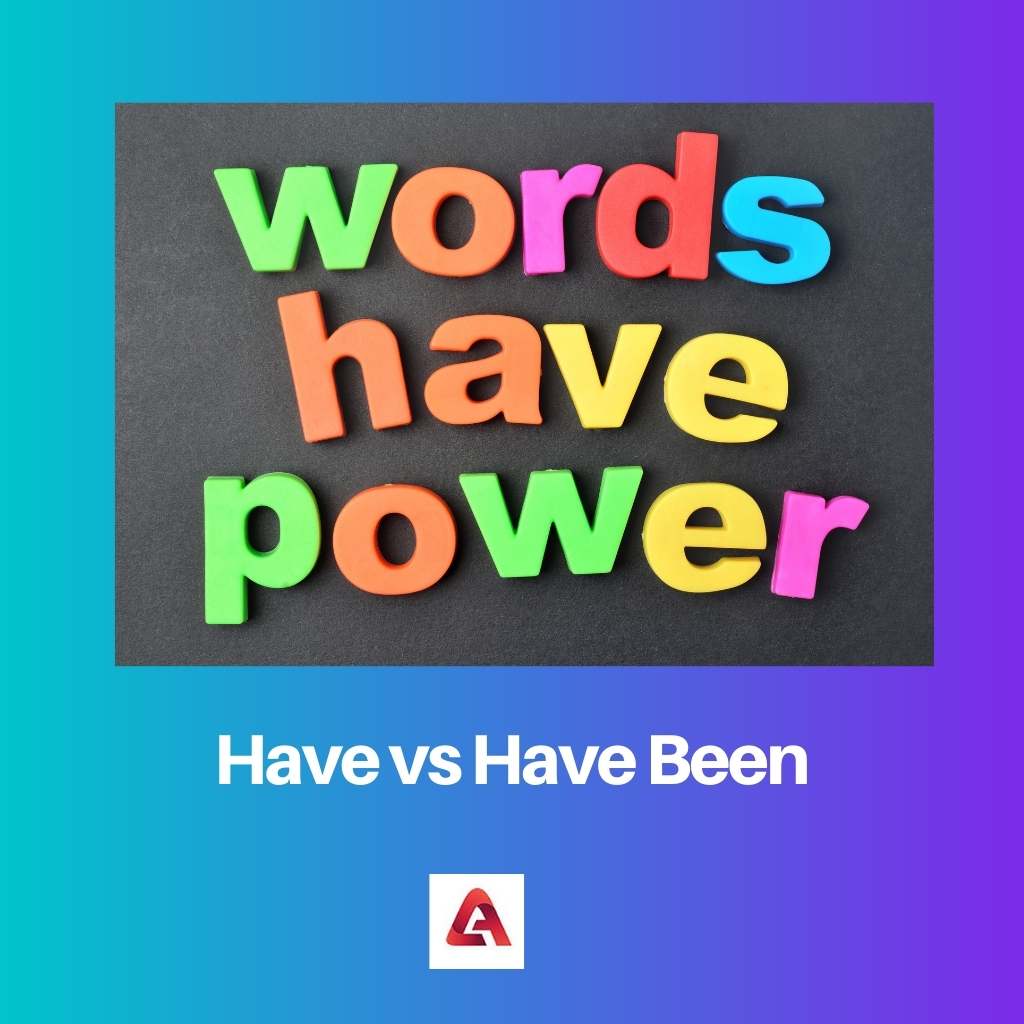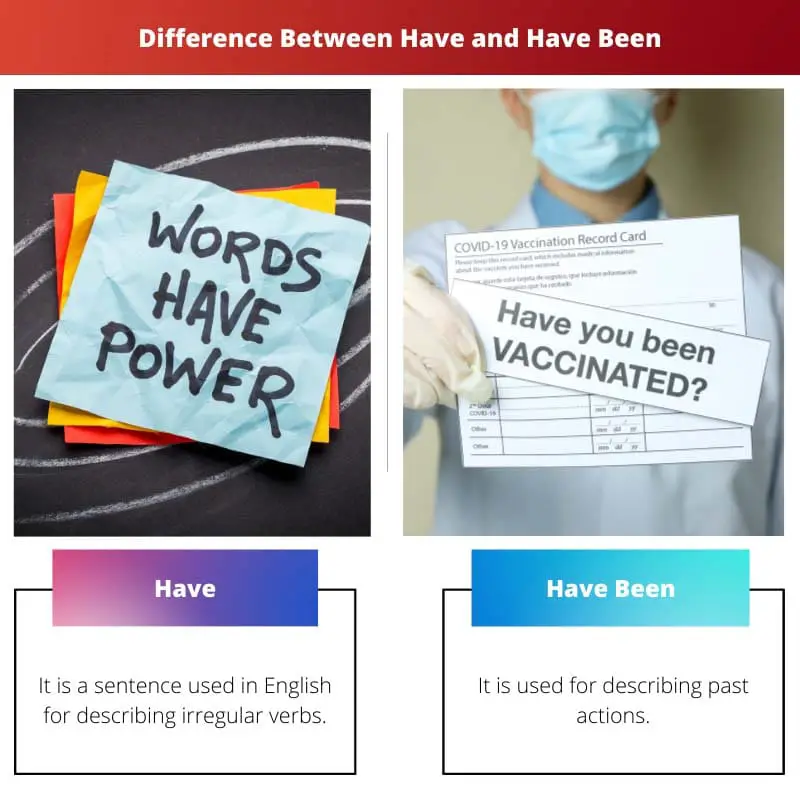We need to learn English grammar to speak the language effectively. If we speak with grammar mistakes or with broken sentences or sentences with improper meaning, then it won’t be appropriate for the other person who hears us speaking.
Key Takeaways
- “Have” is an auxiliary verb used in the present perfect tense, while “have been” is used in the present perfect continuous tense.
- “Have” shows a completed action, whereas “have been” indicates an ongoing action or situation.
- Use “have” when the focus is on the result of an action and “have been” when the focus is on the duration or continuity of action.
Have vs Have Been
The difference between Having and Have Been is that have is used to express sentences in the present perfect tense. But have been being used for expressing sentences that are in the present perfect continuous tense. The verb form that is used in have is an irregular verb. But the verb form used have been being a verbal phrase.

Have is used in English to hold something or to possess. This is used to indicate the possession which is available in the present and not something that happened in the past. This is also used alongside all the pronouns.
It is used in the sentence to describe it to the other person. It can be used with I, you, we, and all. But we cannot use it with him or her. For that, we need to use has been instead of have been.
Comparison Table
| Parameters of Comparison | Have | Have Been |
|---|---|---|
| Definition | It is a sentence used in English to describe irregular verbs | It is used for describing past actions |
| Example | I have to take care of this | They have been talking for 3 hours |
| Use | It is used to possess or contain something | It is used for the first and second-person singular and can be used in all plural uses |
| Verb type | It is an independent verb | It is a verbal phrase |
| Tense | It is used to express the present perfect tense | It is used to express the present perfect continuous tense |
What is Have?
Have comes under irregular verb type. This is used in grammar. People use it to express when they have completed something. Without using have, they cannot frame that sentence.
Likewise, if you are starting to learn English grammar and encounter this have word, you have to start it with simple sentences. Practising it in your daily sentences is the best way to do this.
For describing any events that happened in the past, you need to use had. It is used for describing past tenses. Sometimes, confusion will arise among people about when they should use have and when they should use has.

What is Have Been?
Have been used to indicate something that they have been doing for a long time. That is, the process will be going from what they have started till now. In grammar, have been is used for describing perfect present tense.
Not only is it used in singular forms, but it is also used in plural forms. To put it in simple words, when we want to describe the other person that we have started something in the past, and the process got finished, then, in that case, we use have been for that finished process.
To understand this more in-depth, we should start using it in our daily sentences. It will help us to understand the difference between them. The process that is completed.

Main Differences Between Have and Have Been
- The verb type of have is an irregular verb. On the other hand, the verb type of have been is verbal phrase.
- Have is used for expressing the present perfect tense. On the other hand, they have been being used for expressing the present perfect continuous tense.

- https://search.informit.org/doi/abs/10.3316/aeipt.113365
- https://journals.sagepub.com/doi/pdf/10.1177/003368828401500208

This text provides an insightful comparison and contrast between ‘have’ and ‘have been’. The detailed examples and clear explanations have enriched my understanding of how to use these verbs effectively in constructing sentences.
Understanding the minute distinctions between ‘have’ and ‘have been’ plays a pivotal role in effective language usage. This article meticulously dissects the differences, serving as a valuable resource for learners aiming to enhance their English grammar proficiency.
This text’s detailed analysis of ‘have’ and ‘have been’ serves as an invaluable resource for learners of the English language. The methodical breakdown and clear comparisons offer a comprehensive understanding of these grammatical concepts.
The meticulous breakdown of ‘have’ and ‘have been’ in this article significantly contributes to the comprehensive understanding of English grammar. The depth of explanation and clear examples greatly facilitate the learning process.
The depth of analysis in this text regarding the differences between ‘have’ and ‘have been’ is exceptional. The thorough comparison table highlights the distinctions, enabling readers to gain a comprehensive understanding of these grammatical concepts.
The nuances of English grammar are crucial in effective communication. By understanding the differences between ‘have’ and ‘have been’, individuals can enhance their linguistic skills and conversational abilities. This article aptly dissects these distinctions, providing clarity to the reader.
The English language is complex and fascinating. Learning its grammar rules is necessary to use it effectively. This article provides a detailed explanation of the differences between have and have been. The main differences are based on verb type and tense, addressed methodically in this text.
Thank you for breaking down the differences between have and have been so thoroughly. I appreciate how this makes English grammar more approachable and provides a deeper understanding of these concepts.
I agree with what you mentioned. Understanding the subtleties between have and have been is key to mastering English grammar. The process of grasping these differences can be aided by continuous practice.
This article offers a detailed insight into the grammar nuances of ‘have’ and ‘have been’. The explanations provided exhibit clarity, making it an invaluable resource for individuals looking to strengthen their command of the English language.
Absolutely, the distinctions presented here are enlightening. The clear differentiation and in-depth analysis of ‘have’ and ‘have been’ provide readers with a robust understanding of these grammatical concepts.